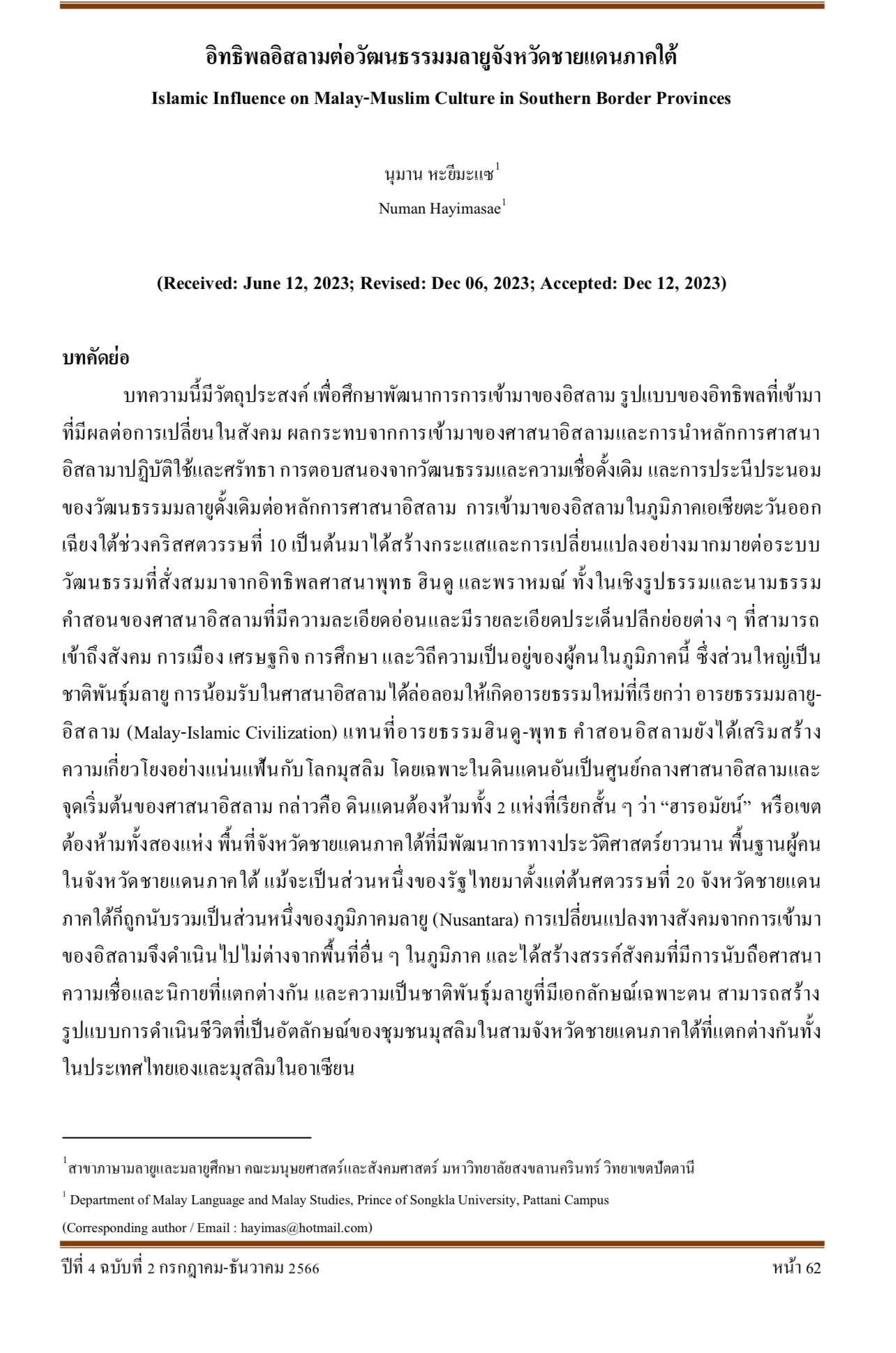Islamic Influence on Malay-Muslim Culture in Southern Border Provinces
Keywords:
Islamic Influence, Malay Culture, Southern Border ProvincesAbstract
This article aims to study the brief historical development the coming of Islam, aspects of influential pattern making change in Malay-Muslim society in Nusantara. The impact of the arrival of Islam and the implementation of Islamic principles and faith responses from traditional cultures and beliefs and their compromise to the tenet of Islam. The arrival of Islam in Southeast Asia from the 10th century onwards has created many trends and changes in cultural systems built on concrete and abstract influences of Buddhism, Hinduism and Brahmanism. Islam comes with teaching and guidance to the various aspects of human life namely society, politics, economy, education and the way of life of the people in this region. The acceptance of Islam has tempted the creation of a new civilization known as Malay-Islamic Civilization (Malay-Islamic Civilization) replacing Hindu-Buddhist civilization Islamic teachings have also forged a strong connection with the Muslim world especially in the lands that are the center of Islam and the beginning of Islam, that is, the two forbidden territories, known as "Haramayn" or the two forbidden land. Southern border provinces has a long journey of history traced back to the early 1st century. Although this area is now as a part of the Thai state, the southern border provinces were included as part of the Malay world (Nusantara). The social change from the arrival of Islam thus proceeded like any other area. in the region and has created a religious society different beliefs and sects and a unique Malay ethnicity can create a lifestyle that is the identity of Muslim communities in the three southern border provinces that are different both in Thailand and Muslims in ASEAN.
References
เอกสารอ้างอิงฉบับภาษาไทย
ไพซอล ดาโอ๊ะ นุมาน หะยีมะแซ อีสมาแอ กาเต๊ะ และมูหัมมัดตอลาล แกมะ. (2565). พลวัตวัฒนธรรมในสังคมมุสลิมจังหวัดชายแดนภาคใต้. วารสารอิสลามศึกษา,13(2): 100-130.
ศรีศักร วัลลิโภดม และคณะ. (2550). เล่าขานตำนานเมืองใต้. กรุงเทพฯ: ศูนย์ศึกษาและพัฒนาสันติวิธี มหาวิทยาลัยมหิดล.
อุมัร อุบัยด์ หะสะนะฮฺ. (2007). ไม่มีการบังคับ แก่นแท้แห่งสาสน์อิสลาม. (มัสลัน มาหะมะ แปล). ยะลา: สถาบันอัสสลาม มหาวิทยาลัยอิสลามยะลา.
เอกสารอ้างอิงฉบับภาษาต่างประเทศ
al-Attas, S. N. (1972). Islam dalam Sejarah dan Kebuyadaan Melayu. Kuala Lumpur: UKM Press.
Darwish Harahap. (1992). Sejarah Pertumbuhan Bahasa Melayu. Pinang : Penerbit USM.
Makmur Haji Harun et al. (2018). Jawi Writing in Malay Archipelago Manuscript: A General Overview”, MATEC Web of Conferences matecconf/ (21-January- 2023)
Muhammad Lazim Lawei. (2005). Sejarah dan Perkembangan Agama Anutan Masyarakat Melayu Patani. Pusat Kebudayaan Islam : Kolej Islam Yala.

Downloads
Published
How to Cite
Issue
Section
License
Copyright (c) 2023 MENARA : Journal of Islamic and Contemporary Issues

This work is licensed under a Creative Commons Attribution-NonCommercial-NoDerivatives 4.0 International License.


